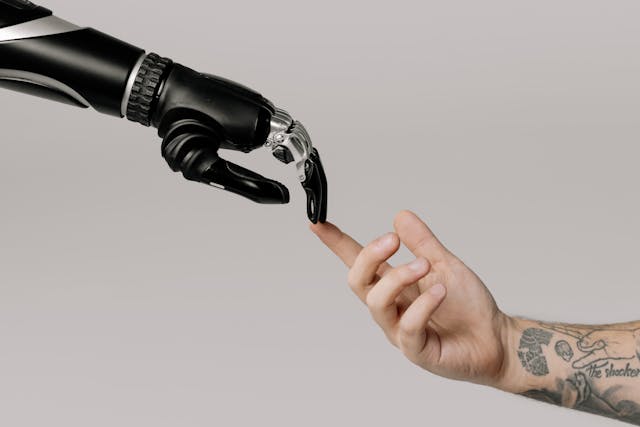At the moment, keeping track of health issues requires various bulky devices, monitors, finger pricks, and lab tests. These are often time-consuming and impractical. Yet, for those needing to monitor what is happening inside their bodies, these technologies are vital. But what if there were an easier way to keep an eye on bodily changes? This is where nanotech smart tattoos enter the picture! Using smart tattoos for health monitoring may just be the most futuristic and hip emerging technology we have heard of in a while! Let’s dive right in to find out more.
What are Nanotech Smart Tattoos?

While they may look like any other tattoo at first glance, these specialized nanotech smart tattoos contain ink that reacts with specific markers under the skin. Therefore, changes in sodium, glucose, and hydration levels will result in a change in color. There are several researchers currently testing out various methods of using smart tattoos for health monitoring. One of those researchers is an associate professor at Imperial College, London, Ali K. Yetisen. Professor Yetisen is currently studying smart tattoos that are capable of measuring bodily interstitial fluid.
These tattoos act as substitutes for blood when tracking various health metrics. Yetisen and his team have produced four tattoos capable of tracking three different metrics. The tattoos are comprised of a pH sensor that changes color from purple to pink, a sodium and pH sensor that glows brighter under UV light, and a glucose sensor that changes from blue to brown. This allows the researchers to take multiple measurements in real time. The biggest hurdle to this approach, however, is that most of the sensors can only change color once and cannot be reused.
Read More: Teen Creates App That Can Spot Heart Disease in Seconds
Magic Ink Smart Tattoos

This hurdle led the assistant professor of mechanical engineering at the University of Colorado Boulder, Carson Bruns, to explore other methods. Bruns focused on creating nanotech smart tattoos that measure various elements externally, instead of those under the skin. Their first design was dubbed the “solar freckle”, a minuscule dot on the skin that senses UV rays. When the wearer is in the shade or indoors, the dot is completely invisible. However, the dot turns blue when it is exposed to UV rays. After applying sunscreen or moving indoors, the dot vanishes again. Bruns and his team have dubbed this technology “Magic Ink” and have also found an application for it in patients undergoing cancer radiation treatment.
At the moment, cancer patients receive small dot tattoos that help doctors target specific areas during treatment. However, these permanent dots often act as unwanted reminders of their dreaded treatments. In situations such as this, Magic Ink would work perfectly as the marks would only be visible when examined by your doctor. The rest of the time, they would be completely invisible to the outside world. The best part is that nanotech smart tattoos can take on any form. This means that it can be designed as a standalone piece or even incorporated into an existing tattoo. In this case, only certain parts of an already existing tattoo would be inked with the Magic Ink.
Read More: The Himalayan invention powered by pine needles
The Emergence of Temporary Smart Tattoos

Just as with real tattoos, there is an alternative for those who do not feel ready to commit to something permanent: temporary smart tattoos. One of the companies exploring this alternative is LogicInk, who offer temporary smart tattoos that are capable of measuring UV light exposure and hydration levels via electrolytes. According to LogicInk’s website, they are also working on new tattoos that will analyze your likelihood of developing various genetic conditions as well as screen for concussions. However, temporary tattoos face many of the same hurdles as other wearable medical technologies. For example, there can be accuracy issues due to factors such as wearers rubbing their skin, sweating, or coming into contact with liquids such as water.
Read More: Scientists Create World’s First 3D-Printed Heart Using Patient’s Own Cells
The Path Forward For Nanotech Smart Tattoos

The teams are currently working on new versions of the tattoo designs, such as Magic Ink’s new tattoo that acts as a permanent sunscreen. These new tattoos are currently being tested in mouse trials. Once proven effective and safe for human use, his team plans to commercialize the product. Yet, while these products may prove effective, will they be adopted by the public at large, or is there still a stigma surrounding tattoos?
Well, it depends on who you ask. One study from 2018 found no link between tattoos and labor market discrimination. However, another study from 2022 revealed that people with visible tattoos were less likely to be hired. Although considering that many of these tattoos are only visible under certain conditions, these barriers could be easily crossed. At the current rate of development, we should see some interesting breakthroughs in nanotech smart tattoos in the next five to ten years.
Read More: China Unveils Smart ‘Band-Aid’ That Wirelessly Delivers Medicine to Organs on Demand
